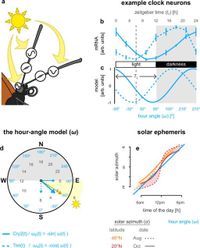In a groundbreaking study, researchers have unveiled a remarkable method by which insects navigate using the sun as a compass, addressing the challenge of compensating for the sun's movement throughout the day. By analyzing how insects like fruit flies utilize neural mechanisms that rely on internal clocks and trigonometric calculations, the research offers insights not only into the world of entomology but also into potential applications in robotics.
Insects are known for their incredible navigational skills, often traveling vast distances across oceans or deserts. However, the success of such navigation heavily depends on their ability to accurately determine the sun's position relative to their own trajectory. The challenge stems from the fact that the sun moves across the sky as the Earth rotates; thus, without any compensatory mechanism, a fixed reference from the sun would lead to navigational errors.
To explore how these tiny navigators maintain accuracy, the research posits that insects may employ complex neural circuitry that allows them to predict the sun's position. "It is implausible to suppose they have either an absolute time reference or a precise look-up table for the solar ephemeris," the authors of the article noted. Instead, the study proposes plausible neural pathways that suggest insects can use their internal sense of time to adjust their compass direction based on the sun's trajectory.
The researchers developed a computational model reflecting how arthropods, such as Drosophila melanogaster, might compute solar azimuth using the hour angle, which describes the Earth’s rotation rate relative to the sun. They also explored various clock inputs from neurons to represent time as a sinusoidal oscillation—akin to a clock managing not just hours but also day lengths—and how these inputs can work in synchrony to inform navigation.
This internal time tracking mechanism relies heavily on proteins, such as timeless and period, found in insect brains that synchronize their circadian and seasonal rhythms. Additionally, the research shows that insects might even interpret their latitude through geomagnetic influences, which can affect their navigational strategies based on their geographical location.
The implications of this study are significant. By employing trigonometric identities in concert with biologically encoded timekeeping, the research depicts a neural architecture that could have profound ramifications for technology. Researchers hinted at a future where robotic systems could adopt these natural navigational strategies, allowing for precise localization in environments where GPS signals are weak or nonexistent.
In rigorous tests mimicking the behavior of foraging insects and migratory patterns, the models demonstrated how crucial the timing compensation becomes when insects are navigating longer distances or through varying latitudinal regions. In simulations where insects could adapt their navigation models to their specific migratory routes, researchers were able to validate their hypothesis that a two-pronged approach—using an hour-angle model for general navigation and a complete model for precision near the equator—enhances efficacy.
Insects such as monarch butterflies, who traverse incredibly long distances, demonstrate that their navigation techniques are not just instinctual but rooted in refined biological computations that account for dynamic environmental cues. The study opens avenues for exploration into how other species may employ similar compensations for their navigational challenges.
Furthermore, the findings indicate that understanding these intricate biological mechanisms not only deepens our comprehension of entomology but may also drive innovations in the field of robotics. By developing autonomous systems that mimic the time-compensated celestial compass of insects, engineers could create machines capable of navigating harsh terrains where traditional navigational references fail.
In conclusion, while our understanding of how insects navigate has evolved significantly, this research highlights a key aspect of that navigational puzzle: the remarkable neural architecture that integrates environmental cues, internal rhythms, and dynamic trigonometric calculations. The study adds a layer of complexity to insect behavior and presents exciting possibilities for merging biological principles with robotic applications, marking a step forward in the quest to harness nature's navigational prowess for technological advancement.

